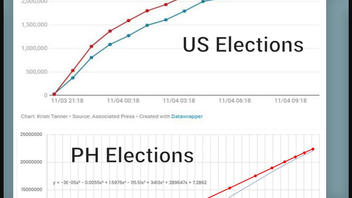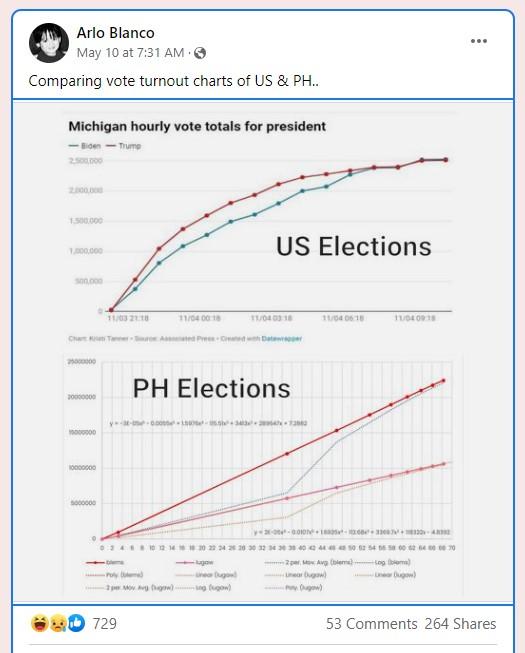
Do these two charts showing election returns -- from Michigan in the U.S. and from the Philippines -- compare voter turnout in the U.S. and the Philippines? No, that's not true: These two graphs that are presented for comparison are not displaying election return data in the same way. The dissimilarity of the design of the two graphs makes it impossible to draw concluding comparisons at a glance. While the vertical axis of both graphs indicates votes, the horizontal axis of the Michigan graph from the 2020 U.S. presidential election measures hours, whereas in the graph of the 2022 Philippine elections the horizontal axis measures the percentage of voter turnout out of one hundred percent.
The two dissimilar graphs were presented together in a Facebook post published on May 10, 2022, in the Facebook group 'Anyone But Bongbong: Remastered.' The graph marked "US Elections" in the Facebook post appears to be nearly identical to the graphic published in a November 4, 2020, Detroit Free Press article titled, "No, Joe Biden did not magically 'find' votes in Michigan". The graph marked "PH elections" appears to have originated on Twitter in a tweet posted by @lordjoshua_ on May 9, 2022. The Facebook post was simply captioned:
Comparing vote turnout charts of US & PH..
This is how the post appeared on Facebook at the time of writing:
(Image source: Facebook screenshot taken on Thu May 12 13:41:07 2022 UTC)
The poster did not make further suggestions as to why the two graphs were being offered together for comparison.
This fact check is not addressing any questions about the election results, only the question of comparing the graph of the U.S. 2020 elections returns in Michigan with another, much more complex calculation purportedly representing the 2022 Philippine elections.
Aside from the differing design of the graphs, the graph representing US turnout only shows one state, Michigan, not all of the United States. The graph also only relays information about the number of votes for Biden and for Trump, but not voter turnout relative to the number of registered voters.
Lead Stories reached out to Peter Cayton, an associate professor at the University of the Philippines School of Statistics, to ask about the graphs in the Facebook post and if they should be compared. He responded by email on May 11, 2022, to explain:
The point of the charts is to compare the rates of vote count transmission. However, for the given Michigan graph, the horizontal axis is by hours. For the Philippines graph, the horizontal axis is by voter turnout out of 100 percent.Already by their dissimilarity, they are inappropriate to be placed together for comparison.













